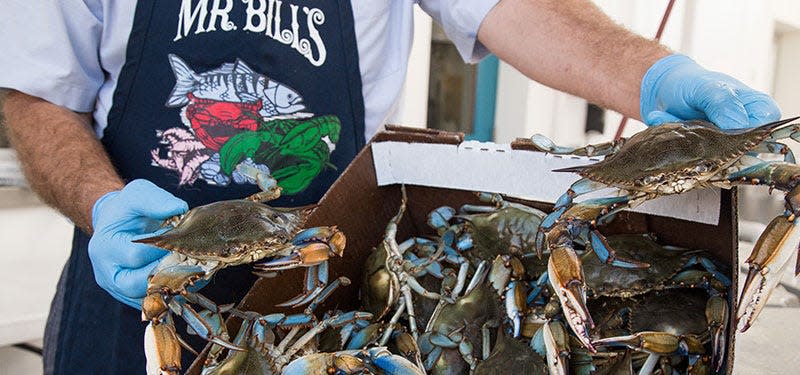Chesapeake crab numbers decline. What will that mean for your summer crab feast?
Tim Glatfelter, whose business is crabs, doesn’t get too excited about the annual blue crab census conducted by Maryland and Virginia.
Some years, to be certain, the census can be alarming. In 2022, the census reported a record low estimate, causing some mild agita among watermen and those who make a living on the tasty crustaceans harvested from the Chesapeake Bay.
This year’s census – called Blue Crab Winter Dredge Survey, conducted by the Maryland’s Department of Natural Resources and Virginia’s Marine Resources Commission – showed a slight drop in crab populations in the bay, from 323 million in 2023 to 317 million this year.
Glatfelter, who runs Mr. Bill’s Seafood headquartered in Lancaster, wasn’t alarmed. “It looks like it’s down percent,” he said. “I don’t know if that’s a significant difference. If the margin of error is two percent, it could be the same.”

Previously: Here's why you'll pay $400+ for a bushel of blue crabs this summer in PA
So, he said he takes the results of the census “with a grain of salt,” or perhaps a grain of Old Bay seasoning, and to view them with some skepticism.
“The proof’s in the pudding,” he said. “We’ll wind up seeing what’s what by the time the season gets here.”
Still, those who keep tabs on the health of the bay – and the economic benefits it can reap – are concerned by the latest census.
“The results of this year’s survey are less than hoped for given the importance of blue crabs in the Chesapeake Bay region,” Chesapeake Bay Foundation Virginia Executive Director Chris Moore said in a statement. “Given the lackluster results of this year’s survey, states should proceed with caution when considering regulatory changes for the upcoming seasons and avoid changes that would increase harvest.”
The survey, conducted over the winter, found the slight drop in overall populations and a decrease in the number of female crabs in the bay, from 152 million last year to 133 million this year. The states had set a target of 215 million female crabs, the number determined to be necessary to maintain a healthy and sustainable crab harvest from the bay.
The figures, since the survey began in 1990, show that crab populations have not rebounded to previous levels, the result of pollution and degradation of the bay. Over the years, the results of the survey have fluctuated wildly. For instance, in 1991, the survey estimated the crab population at 828 million. A year later, that dropped to 367 million. In 1993, though, the survey set the population of crabs at 852 million.
But the trend has been downwards in recent years. Since 2019, the survey has found declining populations, from 594 million that year to 405 million the next year and 282 million in 2021.
Scientists are troubled that the surveys have shown a decline in the number of female and juvenile crabs. The number of juvenile crabs, according to the survey, has been declining for three years. That number has been improving, according to the survey, but remains below average for the fourth year in a row.
All those numbers mean something, Glatfelter said, but they aren’t the only factor when it comes to setting prices for consumers. A number of factors feed the price consumers pay, including the costs of transporting the critters and processing them.
Right now, prices are, in Glatfelter’s estimation, “embarrassing.” Prices are up about 12 percent over last year, he said, a bushel ranging from $289 to $600 depending on the size of the crabs. Part of that, he said, is that the catch this early season hasn’t been great. “This year’s catch is tighter than last year’s,” he said.
However, he said, prices can fluctuate as the season winds in. Later in the summer, as harvests increase, prices come down.
“I would not be forlorn about it,” he said. “We’ll see how it all plays out. I’m optimistic about it.”
Columnist/reporter Mike Argento has been a York Daily Record staffer since 1982. Reach him at mike@ydr.com.
This article originally appeared on York Daily Record: Environmentalists concerned about decline in crabs in the Chesapeake

